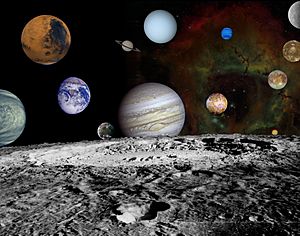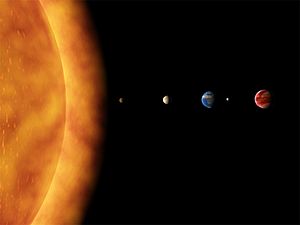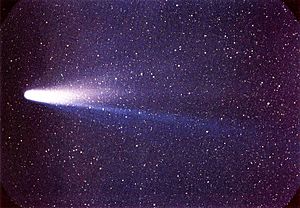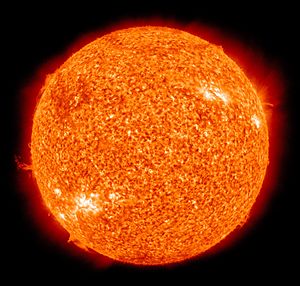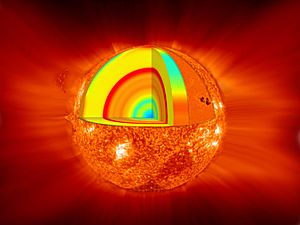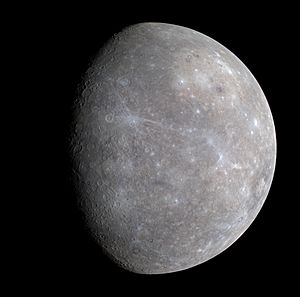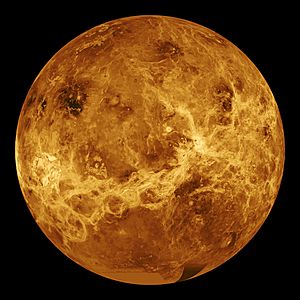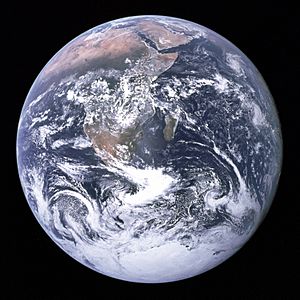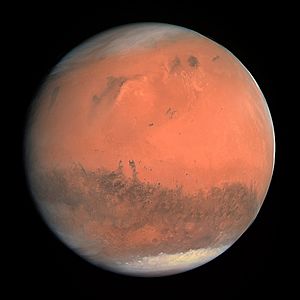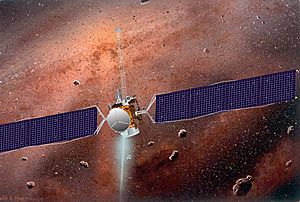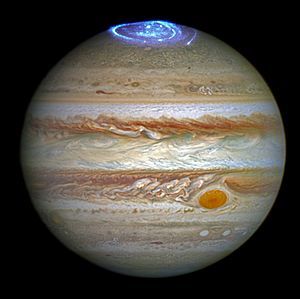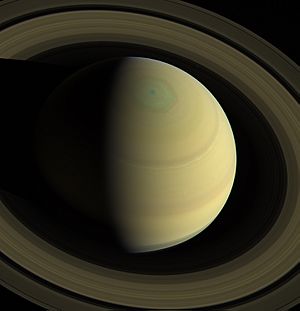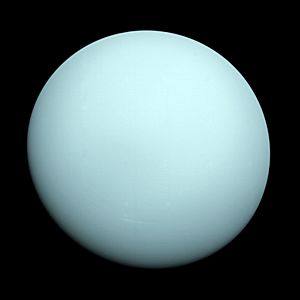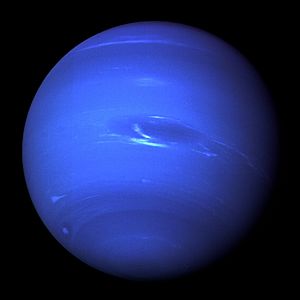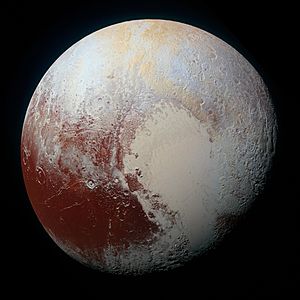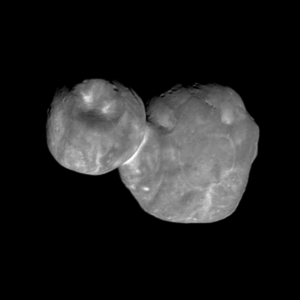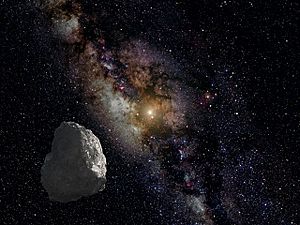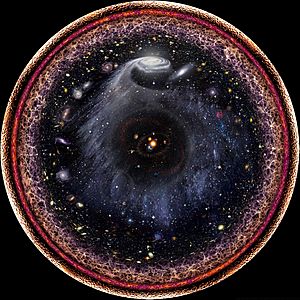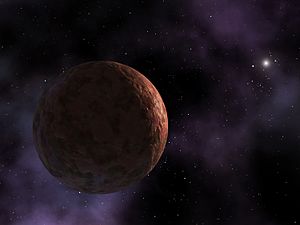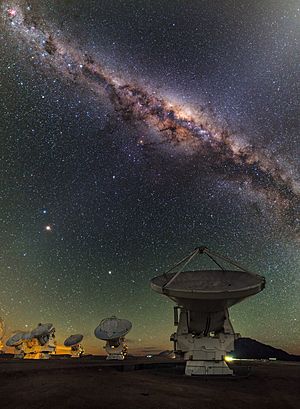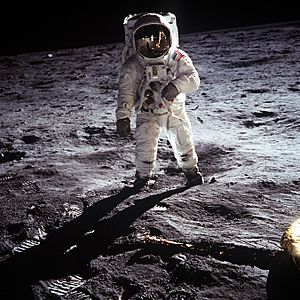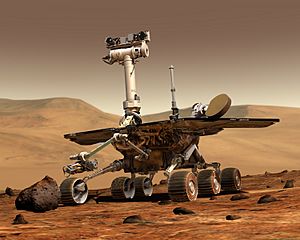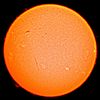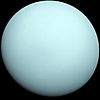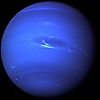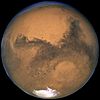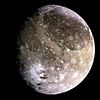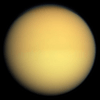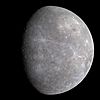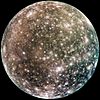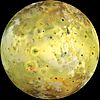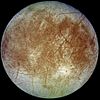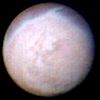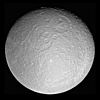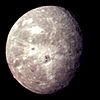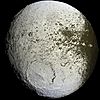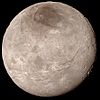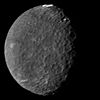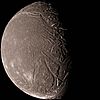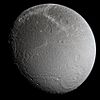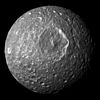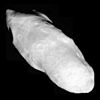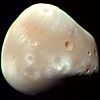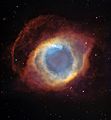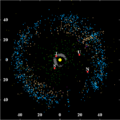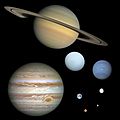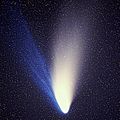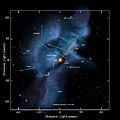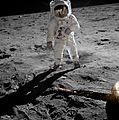Solar System facts for kids
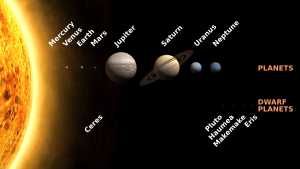
Planets and dwarf planets of the Solar System. Sizes are to scale. Distances from the Sun are not to scale.
|
|
| Age | 4.568 billion years |
|---|---|
| Location | Local Interstellar Cloud, Local Bubble, Orion–Cygnus Arm, Milky Way |
| System mass | 1.0014 solar masses |
| Nearest star | Proxima Centauri (4.22 ly), Alpha Centauri system (4.37 ly) |
| Nearest known planetary system | Alpha Centauri system (4.37 ly) |
| Planetary system | |
| Semi-major axis of outer planet (Neptune) | 4.503 billion km (30.10 AU) |
| Distance to Kuiper cliff | 50 AU |
|
Populations
|
|
| Stars | 1 Sun |
| Planets | 8 Mercury, Venus, Earth, Mars, Jupiter, Saturn, Uranus, Neptune |
| Known dwarf planets | 5 (dozens more awaiting confirmation, possibly hundreds) Ceres, Pluto, Haumea, Makemake, Eris |
| Known natural satellites | 406 (176 of planets and 230 of minor planets) |
| Known minor planets | 597,599 |
| Known comets | 3,175 |
| Identified rounded satellites | 19 |
| Orbit about Galactic Center | |
| Invariable-to-galactic plane inclination | 60.19° (ecliptic) |
| Distance to Galactic Center | 27,000±1,000 ly |
| Orbital speed | 220 km/s |
| Orbital period | 225–250 Myr |
| Star-related properties | |
| Spectral type | G2V |
| Frost line | 2.7 AU |
| Distance to heliopause | ~120 AU |
| Hill sphere radius | ~1–2 ly |
The Solar System is the Sun and all the objects that orbit around it. The Sun is orbited by planets, asteroids, comets and other things.
The Solar System is about 4.6 billion years old. It formed by gravity in a large molecular cloud. Most of this matter gathered in the center, and the rest flattened into an orbiting disk that became the Solar System. It is thought that almost all stars form by this process.
The Sun is a star. It contains 99.9% of the Solar System's mass. This means that it has strong gravity. The other objects are pulled into orbit around the Sun. The Sun is mostly made out of hydrogen, and some helium.
There are eight planets in the Solar System. From closest to farthest from the Sun, they are: Mercury, Venus, Earth, Mars, Jupiter, Saturn, Uranus and Neptune. The first four planets are called terrestrial planets. They are mostly made of rock and metal, and they are mostly solid. The last four planets are called gas giants. This is because they are much larger than other planets and are mostly made of gas.
The Solar System also contains other things. There are asteroid belts, mostly between Mars and Jupiter. Further out than Neptune, there is the Kuiper belt and the scattered disc. These areas have dwarf planets, including Pluto, Haumea, Makemake, Ceres and Eris. There are thousands of very small objects in these areas. There are also comets, centaurs, and there is interplanetary dust.
Six of the planets and three of the dwarf planets are orbited by moons. Furthermore, planetary dust orbits the gas giants. Many other systems like the Solar System have been found. Each of the billions of stars in the Milky Way galaxy might have a planetary system.
Contents
Evolution of the Solar System
The formation and evolution of the Solar System began 4.6 billion years ago with the gravitational collapse of a small part of a giant molecular cloud.
Most of the collapsing mass collected in the centre, forming the Sun, while the rest flattened into a protoplanetary disk of loose dust, out of which the planets, moons, asteroids, and other Solar System bodies formed.
This model, known as the nebular hypothesis, was developed in the 18th (1700s) century by Emanuel Swedenborg, Immanuel Kant, and Pierre-Simon Laplace. It has been adjusted by scientific disciplines such as astronomy, physics, geology, and planetary science. As our knowledge of space has grown, the models have been changed to account for the new observations.
The Solar System has evolved considerably since its initial formation. Many moons have formed from circling discs of gas and dust around their parent planets, while other moons are believed to have formed and were later captured by their planets. Still others, as the Earth's Moon, may be the result of giant collisions.
Many collisions between bodies have occurred, and have been important to the evolution of the Solar System. In the early stages, the positions of the planets sometimes shifted, and planets have switched places. This planetary migration is thought to have been responsible for much of the Solar System's early evolution.
Earth's orbit
The Earth's orbit around the Sun is nearly a perfect circle, but when mapped it is found that the Earth moves around the Sun in a very slightly oval shaped orbit, called an elliptical orbit. The other planets in the Solar System also orbits the Sun in slightly elliptical orbits. Mercury has a more elliptical orbit than the others, and some of the smaller objects orbit the Sun in very eccentric orbits.
Discovery and exploration
For thousands of years, people had no need for a name for the "Solar System". They thought the Earth stayed still at the center of everything (geocentrism). Although the Greek philosopher Aristarchus of Samos suggested that there was a special order in the sky, Nicolaus Copernicus was the first to develop a mathematical system that described what we now call the "solar system". This was called a new "system of the world".
In the 17th century, Galileo Galilei, Johannes Kepler and Isaac Newton began helping people understand physics more clearly. People began to accept the idea that the Earth is a planet and moves around the Sun, and that the planets are worlds with the same physical laws that control Earth. More recently, telescopes and space probes have led to discoveries of mountains and craters, and seasonal meteorological phenomena such as clouds, dust storms and ice caps on the other planets.
Structure and composition
The principal component of the Solar System is the Sun, a star that contains 99.86% of the system's known mass and dominates it gravitation. The Sun's four largest orbiting bodies, the giant planets, account for 99% of the remaining mass, with Jupiter and Saturn together comprising more than 90%. The remaining objects of the Solar System including the four terrestrial planets, the dwarf planets, moons, asteroids, and comets) together comprise less than 0.002% of the Solar System's total mass.
All the planets, and most other objects, orbit the Sun in the same direction that the Sun is rotating (counter-clockwise, as viewed from above Earth's north pole). There are exceptions, such as Halley's Comet.
Most of the planets in the Solar System have secondary systems of their own, being orbited by planetary objects called natural satellites, or moons, two of which, Titan and Ganymede, are larger than the planet Mercury and, in the case of the four giant planets, by planetary rings, thin bands of tiny particles that orbit them in unison.
The Sun
At the center of the Solar System is the Sun.
It is a star, like the billions of other stars in the sky.
The Sun is important to us because it gives us heat and energy that allows life. None of the life on Earth could exist without the Sun.
The rest of the objects in the Solar System orbit (travel around) the Sun. The planets are the largest of these. The planets closest to the Sun are called the inner planets. These are Mercury, Venus, Earth, and Mars. Then comes a big ring of asteroids, chunks of rock much smaller than planets. This ring is called the asteroid belt. Within the asteroid belt, there is a dwarf planet (smaller than a normal planet) named Ceres. Then come the outer planets: Jupiter, Saturn, Uranus, and Neptune. Farther out there are two dwarf planets, Pluto and Eris.
Activity on the Sun's surface, such as solar flares and coronal mass ejections, disturbs the heliosphere, creating space weather and causing geomagnetic storms.
Inner planets
The first four planets closest to the Sun are called the inner planets. They are small and dense terrestrial planets, with solid surfaces.
Mercury
Mercury (0.4 AU from the Sun) is the closest planet to the Sun and the smallest planet in the Solar System (0.055 M⊕). (An Astronomical unit (AU) is a unit of length derived from the Earth's orbit. It is the average distance the Earth gets from the Sun on the long axis of the ellipse.)
Mercury has no natural satellites; besides impact craters, its only known geological features are lobed ridges or rupes that were probably produced by a period of contraction early in its history.
Venus
Venus (0.7 AU from the Sun) is close in size to Earth (0.815 M⊕) and, like Earth, has a thick silicate mantle around an iron core, a substantial atmosphere, and evidence of internal geological activity.
It is much drier than Earth, and its atmosphere is ninety times as dense. Venus has no natural satellites.
It is the hottest planet, with surface temperatures over 400 °C (752 °F), most likely due to the amount of greenhouse gases in the atmosphere.
Earth
Earth (1 AU from the Sun) is the largest and densest of the inner planets, the only one known to have current geological activity, and the only place where life is known to exist.
Its liquid hydrosphere is unique among the terrestrial planets, and it is the only planet where plate tectonics has been observed.
Earth's atmosphere is radically different from those of the other planets, having been altered by the presence of life to contain 21% free oxygen.
It has one natural satellite, the Moon, the only large satellite of a terrestrial planet in the Solar System.
Mars
Mars (1.5 AU from the Sun) is smaller than Earth and Venus (0.107 M⊕). It has an atmosphere of mostly carbon dioxide with a surface pressure of 6.1 millibars (roughly 0.6% of that of Earth).
Its surface, peppered with vast volcanoes, such as Olympus Mons, and rift valleys, such as Valles Marineris, shows geological activity that may have persisted until as recently as 2 million years ago.
Its red colour comes from iron oxide (rust) in its soil.
Mars has two tiny natural satellites (Deimos and Phobos) thought to be either captured asteroids, or ejected debris from a massive impact early in Mars's history.
Asteroid belt
Asteroids are classified as small Solar System bodies and are composed mainly of rocky and metallic minerals, with some ice. They range from a few metres to hundreds of kilometres in size. Asteroids smaller than one meter are usually called meteoroids and micrometeoroids (grain-sized).
The asteroid belt occupies the orbit between Mars and Jupiter. It is thought to be remnants from the Solar System's formation that failed to form because of the gravitational interference of Jupiter.
The asteroid belt is very sparsely populated; spacecraft routinely pass through without incident.
Ceres
Ceres (2.77 AU) is a dwarf planet. Its mass is large enough for its own gravity to pull it into a spherical shape.
Ceres was considered a planet when it was discovered in 1801, and was reclassified to asteroid in the 1850s. It was classified as a dwarf planet in 2006 when the definition of a planet was created.
Outer planets
Jupiter
Jupiter (5.2 AU), at 318 M⊕, is 2.5 times the mass of all the other planets put together. It is composed largely of hydrogen and helium.
Jupiter's strong internal heat creates semi-permanent features in its atmosphere, such as cloud bands and the Great Red Spot.
Jupiter has 79 known satellites. The four largest, Ganymede, Callisto, Io, and Europa, show similarities to the terrestrial planets, such as volcanic activity and internal heating. Ganymede, the largest satellite in the Solar System, is larger than Mercury.
Saturn
Saturn (9.5 AU), with its extensive ring system, has several similarities to Jupiter. Although Saturn has 60% of Jupiter's volume, it is less than a third as massive, at 95 M⊕.
Saturn is the only planet of the Solar System that is less dense than water.
The rings of Saturn are made up of small ice and rock particles.
Saturn has 62 confirmed satellites composed largely of ice. Two of these, Titan and Enceladus, show signs of geological activity. Titan, the second-largest moon in the Solar System, is larger than Mercury and the only satellite in the Solar System with a substantial atmosphere.
Uranus
Uranus (19.2 AU), at 14 M⊕, is the lightest of the outer planets. Unlike the planets, it orbits the Sun on its side.
It has a much colder core than the other giant planets and radiates very little heat into space.
Uranus has 27 known satellites, the largest ones being Titania, Oberon, Umbriel, Ariel, and Miranda.
Neptune
Neptune (30.1 AU), though slightly smaller than Uranus, is more massive (17 M⊕) and hence more dense.
It radiates more internal heat, but not as much as Jupiter or Saturn.
Neptune has 14 known satellites. The largest, Triton, is geologically active, with geysers of liquid nitrogen. Triton is the only large satellite with a retrograde orbit.
Neptune is accompanied in its orbit by several minor planets, termed Neptune trojans, that are in 1:1 resonance with it.
Dwarf planets
Pluto had been called a planet since it was discovered in 1930, but in 2006 astronomers meeting at the International Astronomical Union decided Pluto did not fit into the definition of a planet. Instead they called it a dwarf planet along with some others. These small planets are sometimes called plutinos.
Trans-Neptunian region
Beyond the orbit of Neptune lies the area of the "trans-Neptunian region", with the doughnut-shaped Kuiper belt, home of Pluto and several other dwarf planets, and an overlapping disc of scattered objects, which is tilted toward the plane of the Solar System and reaches much further out than the Kuiper belt.
The entire region is still largely unexplored.
It appears to consist overwhelmingly of many thousands of small worlds—the largest having a diameter only a fifth that of Earth and a mass far smaller than that of the Moon—composed mainly of rock and ice.
This region is sometimes described as the "third zone of the Solar System", enclosing the inner and the outer Solar System.
Ultima Thule is a trans-Neptunian object located in the Kuiper belt.
With the New Horizons space probe's flyby on 1 January 2019 (UTC time), it became the farthest and most primitive object in the Solar System visited by a spacecraft.
It was discovered on 26 June 2014 by astronomer Marc Buie using the Hubble Space Telescope.
Farthest regions
The point at which the Solar System ends and interstellar space begins is not precisely defined because its outer boundaries are shaped by two separate forces: the solar wind and the Sun's gravity. It is thought to extend up to a thousand times farther and contain the Oort cloud.
Oort cloud
The Oort cloud is a hypothetical spherical cloud of up to a trillion icy objects. It is thought to be composed of comets that were ejected from the inner Solar System by gravitational interactions with the outer planets. The Oort cloud objects move very slowly, and can be interrupted by infrequent events, such as collisions, the gravitational effects of a passing star, or the galactic tide, the tidal force exerted by the Milky Way.
Boundaries
Much of the Solar System is still unknown. The Sun's gravitational field is estimated to dominate the gravitational forces of surrounding stars out to about two light years (125,000 AU). Objects may yet be discovered in the Solar System's uncharted regions.
Galactic context
The Solar System is located in the Milky Way, a barred spiral galaxy with a diameter of about 100,000 light-years containing about 100 billion stars. The Sun resides in one of the Milky Way's outer spiral arms, known as the Orion–Cygnus Arm or Local Spur.
The Solar System's location in the Milky Way is a factor in the evolutionary history of life on Earth. Its orbit is close to circular, and orbits near the Sun are at roughly the same speed as that of the spiral arms.
Exploration
Before the telescope, people explored the sky with their eyes. They saw how the planets seemed to "wander" through the sky. They learned to predict where the Sun, the moon, and planets would be in the sky. They built some observatories - places for watching the sky. They observed the Sun and stars to tell the time of year.
Telescopes were first made in the early 17th century and have vastly improved since. Astronomers saw that planets are not like stars. They are worlds, like the Earth. They could see that some planets have moons. They began to think about what these worlds were like. At first, some thought that the other planets and moons had life. Eventual progress sent spacecraft into space, and found that there life on the Moon or on Mars.
Twelve Astronauts walked on the Moon about 35 years ago. They brought rocks and dirt back to Earth. Spacecraft flew by Venus, Mars, and the outer planets. The pictures they took showed us a lot of what we know about these worlds.
Robots landed on Mars in 1971, 1976, and 1997. They took thousands of pictures of the planets. They also check rocks to find out what the rocks are made of.
So far, we have not found any life except on Earth. Maybe tiny one-celled life once lived on Mars. Maybe there is life under the ice on Jupiter's moon Europa. New spacecraft are being planned to look for life on these worlds.
Visual summary
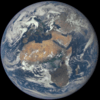 |
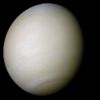 |
|||||
| Sun (star) |
Jupiter (planet) |
Saturn (planet) |
Uranus (planet) |
Neptune (planet) |
Earth (planet) |
Venus (planet) |
| Mars (planet) |
Ganymede (moon of Jupiter) |
Titan (moon of Saturn) |
Mercury (planet) |
Callisto (moon of Jupiter) |
Io (moon of Jupiter) |
Moon (moon of Earth) |
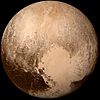 |
||||||
| Europa (moon of Jupiter) |
Triton (moon of Neptune) |
Pluto (Kuiper belt object) |
Titania (moon of Uranus) |
Rhea (moon of Saturn) |
Oberon (moon of Uranus) |
Iapetus (moon of Saturn) |
| Charon (moon of Pluto) |
Umbriel (moon of Uranus) |
Ariel (moon of Uranus) |
Dione (moon of Saturn) |
Tethys (moon of Saturn) |
Ceres (belt asteroid) |
Vesta (belt asteroid) |
| Enceladus (moon of Saturn) |
Miranda (moon of Uranus) |
Proteus (moon of Neptune) |
Mimas (moon of Saturn) |
Hyperion (moon of Saturn) |
Phoebe (moon of Saturn) |
Janus (moon of Saturn) |
| Epimetheus (moon of Saturn) |
Lutetia (belt asteroid) |
Prometheus (moon of Saturn) |
Pandora (moon of Saturn) |
Mathilde (belt asteroid) |
Helene (moon of Saturn) |
Ida (belt asteroid) |
| Phobos (moon of Mars) |
Deimos (moon of Mars) |
2014 MU69 (Kuiper Belt object) |
Images for kids
-
The Helix Nebula, a planetary nebula similar to what the Sun will create when it enters its white dwarf stage
-
Overview of the Inner Solar System up to the Jovian System
-
Plot of objects around the Kuiper belt and other asteroid populations, the J, S, U and N denotes Jupiter, Saturn, Uranus and Neptune
-
Comet Hale–Bopp seen in 1997
-
Beyond the heliosphere is the interstellar medium, consisting of various clouds of gases. The Solar System currently moves through the Local Interstellar Cloud, here shown along with neighbouring clouds and the two closest unaided visible stars.
-
Buzz Aldrin on the Moon during the Apollo 11 mission
See also
 In Spanish: Sistema solar para niños
In Spanish: Sistema solar para niños


